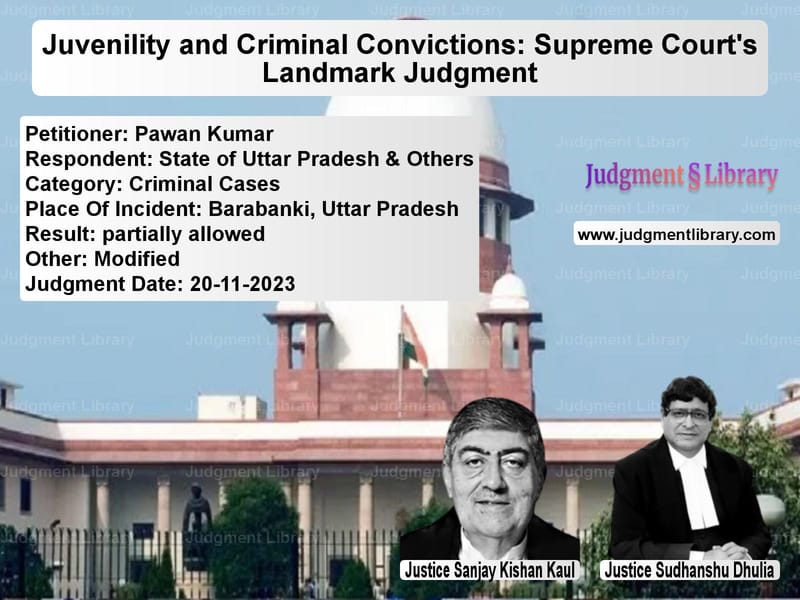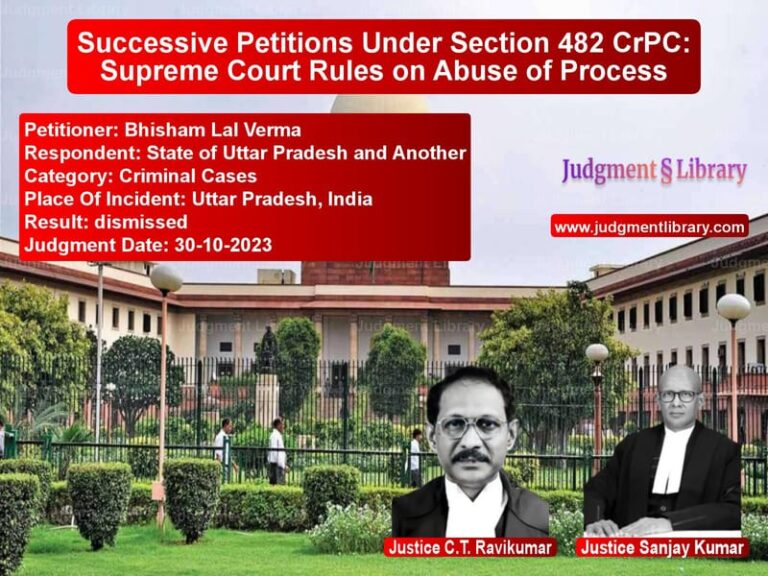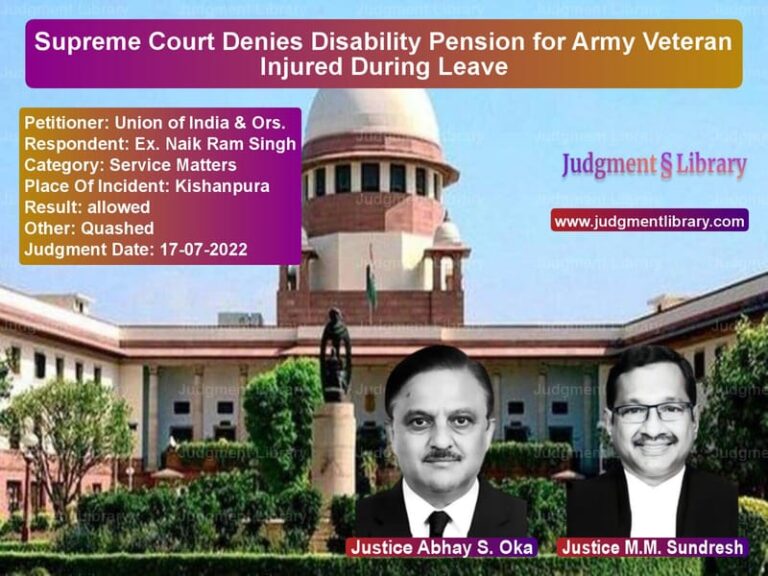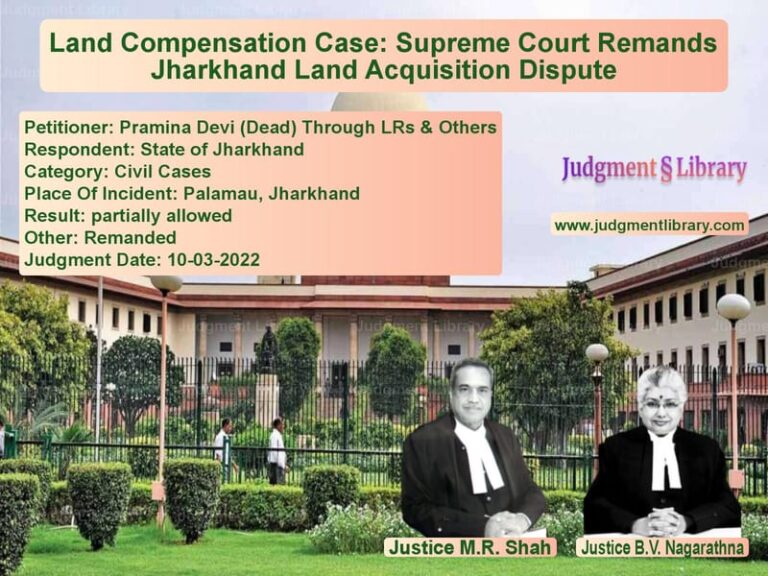Juvenility and Criminal Convictions: Supreme Court’s Landmark Judgment
The case of Pawan Kumar v. State of Uttar Pradesh & Others brings into focus the crucial aspect of determining juvenility in criminal cases. The Supreme Court had to decide whether the appellant, Pawan Kumar, who had been convicted for murder and attempted murder, was a juvenile at the time of the crime, and whether he should be given the legal protection provided under the Juvenile Justice Act.
Background of the Case
Pawan Kumar was convicted by the Additional Sessions Judge, Barabanki in Sessions Trial No. 85 of 1996 for offenses under Sections 302 and 307 read with Section 34 of the Indian Penal Code, 1860. He was sentenced to life imprisonment under Section 302/34 and seven years of rigorous imprisonment under Section 307/34. His conviction was upheld by the High Court of Judicature at Allahabad (Lucknow Bench) on May 7, 2019.
The case involved four accused individuals—Gaya Prasad Mishra, Gulab Chandra, Pawan Kumar, and Babadeen. Babadeen passed away during the trial, and his case stood abated. The remaining three were convicted. However, Gaya Prasad Mishra and Gulab Chandra, who were the father and brother of the appellant, respectively, were released prematurely after spending over 19 years in jail under the remission policy of the State.
Legal Challenge and Juvenility Claim
The appellant, Pawan Kumar, apart from challenging his conviction, raised a significant legal claim—he argued that he was a juvenile at the time of the crime (December 1, 1995). Both the Trial Court and the High Court had dismissed this plea. However, he persisted with his claim, arguing that his plea had not been considered under the true letter and spirit of the applicable juvenile laws.
Arguments of the Parties
The counsel for the appellant, Ms. Vanshaja Shukla, contended that Pawan Kumar was below the age of 16 years at the time of the offense and that his juvenility plea was rejected without a proper inquiry. She submitted:
“The plea of juvenility may be considered first as the claim of the appellant indeed was that at the time of the incident, he was a juvenile, and his plea of juvenility had not been considered in the true letter and spirit of the applicable law.”
On the other hand, the State of Uttar Pradesh, represented by the Additional Advocate General, Mr. Ardhendumauli Kumar Prasad, countered this argument, stating that the Trial Court had already conducted an inquiry and found that Pawan Kumar was not a juvenile at the time of the offense.
Supreme Court’s Observations
The Supreme Court examined the procedural history of the case, noting that the appellant had raised the juvenility plea since the time of his trial, albeit belatedly. Initially, the Trial Court and the appellate courts found that the appellant was not a juvenile based on a medical ossification test and a family register entry stating his birth year as 1975. However, upon further review, the Supreme Court noted discrepancies in the assessment of the appellant’s age.
The key observations of the Supreme Court included:
- The appellant’s school records consistently showed his date of birth as July 5, 1980, meaning he was 15 years, 4 months, and 26 days old at the time of the crime.
- The medical ossification test conducted at the time estimated his age to be around 19 years, but such tests have a recognized margin of error.
- Under Rule 12 of the Juvenile Justice (Care and Protection of Children) Rules, 2007, a school leaving certificate from the first attended school holds greater evidentiary value than an ossification test.
- The principle of giving the benefit of the doubt to the accused in cases of conflicting evidence regarding age was not applied properly by the lower courts.
Supreme Court’s Ruling
The Supreme Court accepted the report dated September 28, 2022, filed by the Additional Sessions Judge, Barabanki, which determined that the appellant’s date of birth was July 5, 1980. Based on this, the Supreme Court concluded:
“We accept the report of the Additional Sessions Judge, Barabanki dated 28.09.2022, and declare that the appellant was a juvenile on the date of the commission of the crime, i.e., on 01.12.1995.”
However, since the appellant had already been convicted for a serious offense (murder), the Supreme Court upheld his conviction under Sections 302 and 307 IPC but quashed the sentence, citing Section 16 of the Juvenile Justice Act, 2000, which states that a juvenile cannot be sentenced to death or life imprisonment.
Implications of the Judgment
The judgment reaffirms important legal principles:
1. Benefit of Doubt in Juvenility Claims
The Supreme Court reinforced that when conflicting evidence regarding age exists, the benefit of the doubt should be given to the accused, particularly in borderline cases.
2. Evidentiary Value of School Records
The ruling clarifies that a school leaving certificate from the first attended school carries more weight than medical ossification tests or family register entries.
3. Application of Juvenile Justice Laws
The case highlights the retrospective application of the Juvenile Justice Act, ensuring that juvenility claims raised at any stage, even post-conviction, must be considered properly.
4. Sentence Modification for Juveniles
Even if convicted, a juvenile cannot be given life imprisonment or the death penalty. The Supreme Court’s intervention ensured that the appellant was released, having already served more than the maximum detention period of three years prescribed for juveniles.
Conclusion
The Supreme Court’s decision in Pawan Kumar’s case serves as a significant precedent in cases concerning the determination of juvenility in criminal matters. By upholding the principles of fair inquiry and legal protection for juveniles, the judgment reinforces the need for a careful and sensitive approach in dealing with young offenders. The case underscores the evolving nature of the Indian legal system in safeguarding the rights of juveniles while maintaining the integrity of the criminal justice process.
Petitioner Name: Pawan Kumar.Respondent Name: State of Uttar Pradesh & Others.Judgment By: Justice Sanjay Kishan Kaul, Justice Sudhanshu Dhulia.Place Of Incident: Barabanki, Uttar Pradesh.Judgment Date: 20-11-2023.
Don’t miss out on the full details! Download the complete judgment in PDF format below and gain valuable insights instantly!
Download Judgment: pawan-kumar-vs-state-of-uttar-prade-supreme-court-of-india-judgment-dated-20-11-2023.pdf
Directly Download Judgment: Directly download this Judgment
See all petitions in Juvenile Justice
See all petitions in Bail and Anticipatory Bail
See all petitions in Murder Cases
See all petitions in Judgment by Sanjay Kishan Kaul
See all petitions in Judgment by Sudhanshu Dhulia
See all petitions in partially allowed
See all petitions in Modified
See all petitions in supreme court of India judgments November 2023
See all petitions in 2023 judgments
See all posts in Criminal Cases Category
See all allowed petitions in Criminal Cases Category
See all Dismissed petitions in Criminal Cases Category
See all partially allowed petitions in Criminal Cases Category







